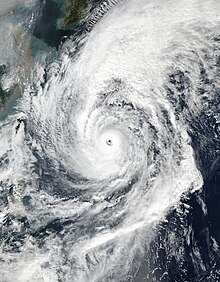 Typhoon Lan nearing peak intensity south of Japan on October 21 | |
| Meteorological history | |
|---|---|
| Formed | October 15, 2017 |
| Dissipated | October 23, 2017 |
| Very strong typhoon | |
| 10-minute sustained (JMA) | |
| Highest winds | 185 km/h (115 mph) |
| Lowest pressure | 915 hPa (mbar); 27.02 inHg |
| Category 4-equivalent super typhoon | |
| 1-minute sustained (SSHWS/JTWC) | |
| Highest winds | 250 km/h (155 mph) |
| Lowest pressure | 922 hPa (mbar); 27.23 inHg |
| Overall effects | |
| Fatalities | 17 total |
| Damage | $2 billion (2017 USD) |
| Areas affected | Caroline Islands, Philippines, Japan, South Korea |
| IBTrACS | |
Part of the 2017 Pacific typhoon season | |
Typhoon Lan, known in the Philippines as Super Typhoon Paolo, was the third-most intense tropical cyclone worldwide in 2017, behind only hurricanes Irma and Maria in the Atlantic. A very large storm, Lan was the twenty-first tropical storm and ninth typhoon of the annual typhoon season. It originated from a tropical disturbance that the United States Naval Research Laboratory had begun tracking near Chuuk on October 11. Slowly consolidating, it developed into a tropical storm on October 15, and intensified into a typhoon on October 17. It expanded in size and turned northward on October 18, although the typhoon struggled to intensify for two days. On October 20, Lan grew into a very large typhoon and rapidly intensified, due to favorable conditions, with a large well-defined eye, reaching peak intensity as a "super typhoon" with 1-minute sustained winds of 249 km/h (155 mph) – a high-end Category 4-equivalent storm – late on the same day. Afterward, encroaching dry air and shear caused the cyclone to begin weakening and turn extratropical, before it struck Japan on October 23 as a weaker typhoon. Later that day, it became fully extratropical before it was absorbed by a larger storm shortly afterward.
Lan caused significant impacts in Japan, with over 380,000 evacuations occurring in Japan, and the cancellations of several domestic flights. In total, approximately 17 deaths were attributed to the typhoon, mainly due to flooding from its rainbands. Damage totals were estimated to have been at least US$2 billion (2017 USD), making it one of the costliest typhoons to have struck Japan.